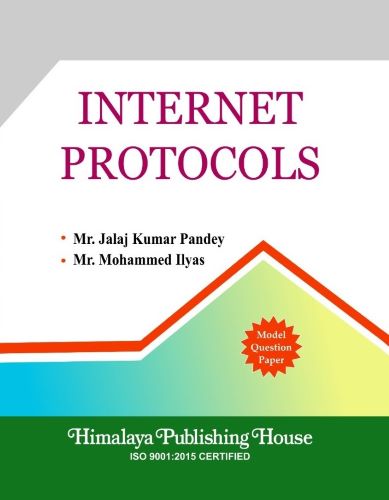Internet Protocols is a foundational subject in the field of Computer Science, essential for students aiming to excel in areas such as network architecture, communication systems, cyber Security, and distributed computing. This subject introduces learners to the principles, structures, and standards that form the backbone of the internet and modern communication networks.
This textbook has been meticulously developed in alignment with the syllabus prescribed by Osmania University. It is designed to offer a clear, concise, and up-to-date understanding of the core concepts of internet protocols and related technologies. The book serves as a comprehensive resource for both foundational learning and advanced exploration in the domain of computer networking.
The primary objective of this textbook is to equip students with the knowledge and skills required to understand, implement, and troubleshoot networking protocols. The content begins with the basics of protocols and standards, and progressively covers critical topics such as IP addressing, subnetting, routing mechanisms, TCP/IP architecture, and application-level protocols including Telnet, FTP, SMTP, and DNS. Special attention is given to modern topics such as IPv6 and dynamic routing protocols, ensuring students are well-prepared for contemporary networking challenges.
Each unit of the book includes:
● Objective type questions (Fill in the blanks and multiple-choice questions) with answers
● Short answer and long answer type questions for exam preparation and conceptual clarity
Contents –
1. Protocols and Standards
1.1 Protocols and Standards
1.1.1 Protocols
1.1.2 Standards
1.1.3 TCP/IP Protocol Suite
1.1.4 Addressing
1.2 IP Addressing
1.2.1 Decimal Notation
1.2.2 Classes
1.2.3 Special Addresses
1.2.4 Unicast, Multicast, and Broadcast Addresses
1.3 Subnetting and Supernetting
1.3.1 Subnetting
1.3.2 Supernetting
1.3.3 Masking
1.4 Delivery and Routing of IP Packets
1.4.1 Connection-Oriented Services (TCP)
1.4.2 Connectionless (UDP)
1.4.3 Direct vs. Indirect Delivery
1.4.4 Routing Methods
1.4.5 Static vs. Dynamic Routing
1.5 Questions
2. Internet Protocol
2.1 Internet Protocol
2.1.1 IPv4
2.1.2 Datagram
2.1.3 Fragmentation
2.1.4 Checksum
2.1.5 Options
2.2 Address Resolution Protocol (ARP)
2.2.1 ARP Packet Format
2.2.2 Encapsulation
2.2.3 Proxy ARP
2.2.4 Operations
2.2.5 RARP
2.2.6 RARP Operation
2.2.7 RARP Packet Format & Encapsulation
2.3 Internet Control Message Protocol (ICMP)
2.3.1 Types of Messages
2.3.2 Message Format
2.3.3 ICMP Encapsulation
2.3.4 Error Reporting Messages
2.3.5 ICMP Query Messages
2.4 Internet Group Management Protocol (IGMP)
2.4.1 Basic operations of IGMP
2.5 Questions
3. Routing Protocols
3.1 Routing Protocols
3.2 Open Shortest Path First (OSPF)
3.2.1 OSPF Packet Format
3.2.2 OSPF Packet Types
3.2.3 OSPF Area Types
3.2.4 OSPF Metric (OSPF Cost)
3.2.5 Link State Routing
3.2.6 OSPF Link Types
3.3 Border Gateway Protocol (BGP)
3.3.1 The Internet’s Routing Protocol
3.3.2 BGP Peers (Neighbours)
3.3.3 BGP Packet Format
3.3.4 Functions of BGP
3.3.5 BGP Path Vector Routing
3.3.6 BGP Message Format
3.4 Next Generation IPv6
3.4.1 IPv6Work Principle
3.4.2 IPv6 Addressing
3.4.3 IPv6 Packet Format
3.4.4 Difference Between IPv4 and IPv6
3.5 Questions
4. Transmission Control Protocol
4.1 Transmission Control Protocol (TCP)
4.1.1 How Exactly do TCP Connections Work?
4.1.2 The Three-way Handshake
4.1.3 TCP Teardown: How a Controlled TCP Connection Termination Works
4.1.4 Structure of the TCP Header
4.2 TCP Services
4.2.1 Advantages and Disadvantages of TCP
4.2.2 TCP Options
4.2.3 Checksum
4.2.4 Flow Control
4.2.5 Introduction to Sliding Window Protocol
4.2.6 Congestion Control
4.2.7 Congestion Avoidance
4.2.8 Congestion Detection
4.2.9 Differences in Flow control and Congestion Control
4.3 Error Control
4.4 No Error in Transmission
4.5 Timers
4.6 Connection
4.6.1 TCP Connection Establishment
4.6.2 Advantages of TCP Connection Establishment
4.6.3 Disadvantages of TCP Connection Establishment
4.6.4 Applications of TCP Connection Establishment
4.7 User Datagram Protocol
4.7.1 Features of UDP Protocol
4.7.2 UDP Protocol
4.7.3 UDP Header Format
4.7.4 Queuing in UDP Protocol
4.8 Questions
5. Telnet
5.1 TELNET in Computer Networks
5.2 FTP Protocol
5.2.1 Connections
5.2.2 Communications
5.2.3 FTP Clients
5.2.4 Features of FTP
5.2.5 Applications of File Transfer Protocol
5.2.6 Advantages and Disadvantages of FTP
5.2.7 Command Processing
5.2.8 File Transfer
5.3 Simple Mail Transfer Protocol (SMTP)
5.3.1 Agents
5.3.2 Addresses
5.3.3 Delayed Delivery
5.4 Aliases
5.5 MTA
5.6 Commands and Responses
5.7 Mail Transfer Phases
5.8 MIME
5.9 POP
5.9.1 Domain Name System (DNS)
5.9.2 Domain Name System Architecture
5.9.3 Domain Name System Server
5.9.4 Distribution
5.9.5 DNS in Internet
5.10 Questions
Model Question Paper







